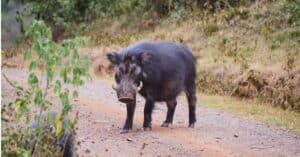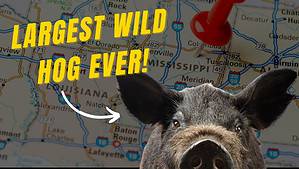Feral hogs are a dangerous and destructive invasive species in the United States. They have been found in 40 of the 50 states. Experts estimate there may be as many as nine million wild boars on the loose. And the population is growing all the time. Columbus first brought them to America as a food source for sailors. Since that time, feral hogs have destroyed delicate natural habitats. They have also posed a threat of diseases and physical attacks on people and domestic livestock. Today, they cost farmers and other property owners millions in damages every year. New York is one of the states that are plagued by feral hogs. In this article, we’ll reveal where feral hogs in the state of New York live, what kinds of problems they can cause, and how authorities are trying to monitor and control them.
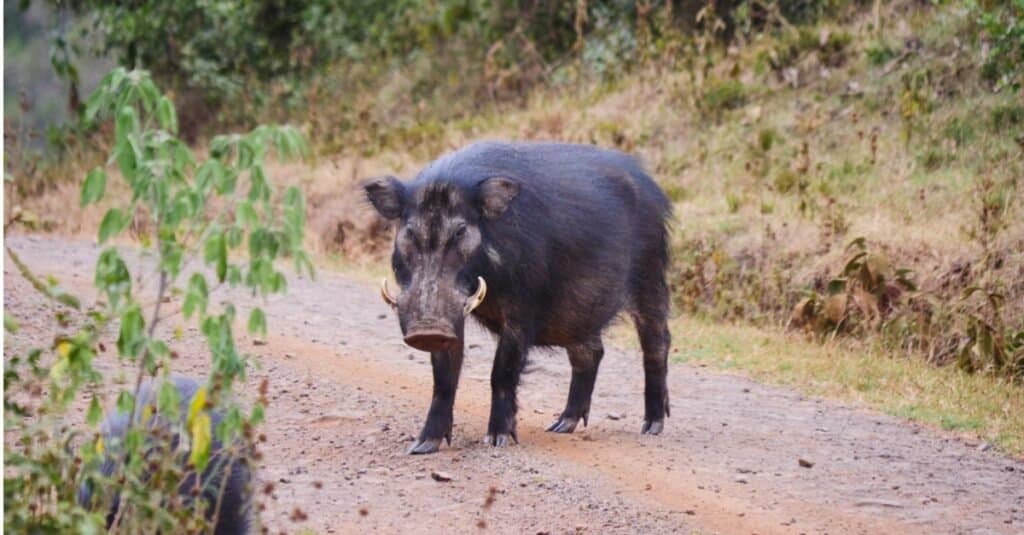
Feral hogs are an invasive species found in all but 10 of the U.S. states.
©iStock.com/chingkai huang
Where Did Feral Hogs Come From?
Pigs are indigenous to Europe and Asia. They were first brought to the New World on Christopher Columbus’s voyages. Explorers released them on Caribbean islands to reproduce as a food source for future colonists. Other explorers repeated this practice on the mainland of North America, starting in Florida. Over the centuries, domestic pigs escaped from colonial farms and joined wild herds. Now, they number an estimated nine million in the United States and have roamed into several Canadian provinces as well. These are the 10 states with the largest feral swine populations:
- Texas (3 million)
- Oklahoma (1.5 million)
- Louisiana (750,000)
- Georgia (600,000)
- Florida (500,000)
- New Mexico (500,000)
- South Carolina (450,000)
- California (400,000)
- Hawaii (400,000)
- Alabama (250,000)

Early explorers released pigs in the New World to multiply and become a familiar food source.
©Simon Dannhauer/Shutterstock.com
Where Have Feral Hogs in New York Been Spotted?
New York State documented four herds located in Tioga, Cortland/Onondaga, Delaware/Sullivan, and Clinton Counties. Escapees from wild boar hunting preserves are likely the source of some of this population. However, authorities believe those in Clinton County may have been intentionally released to create a wild hunting population. Aggressive efforts to obliterate these herds appear to have been successful. No feral pigs have been reported in New York since 2017. However, it is hard to find small numbers of swine. If there are still some roaming the woods of rural New York, they may not be detected. And it is always possible for herds to roam into the state from neighboring states or Canada.
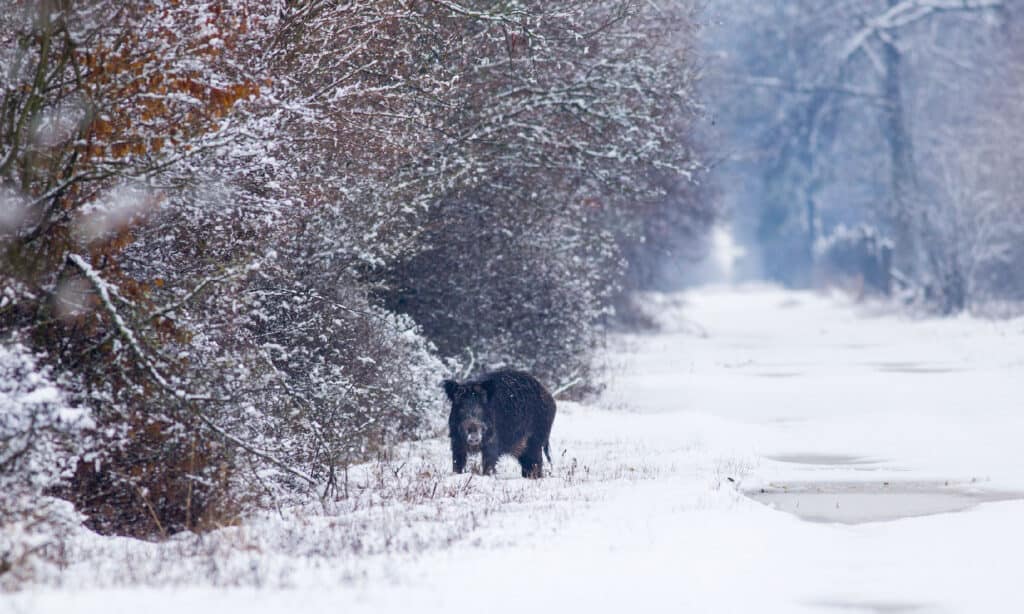
Wild pigs can thrive in all sorts of different climates, including the frosty New York and Canadian winters.
©iStock.com/Jevtic
Why Are Feral Pigs Considered a Problem?
So, what’s the big deal? Now that there are so many wild pigs loose, why not just let them live in the ecosystem? There are three big reasons why feral hogs are an issue: they are dangerous, they cost a lot of money, and they damage the environment. Let’s look at each of these:
An Aggressive and Infected Species
Feral pigs have an aggressive nature, especially during mating season or when defending their young. They are highly territorial and will not hesitate to attack people or animals larger than them. They can inflict deep bites and the males develop long curved tusks they can use to gore their enemies. It’s not unusual for males on the wrong end of a fight to be killed in the struggle. In populated areas, feral pigs may attack domestic livestock, pets, children, or adults. Pigs are omnivorous and have been known to kill lambs or calves for food.
They also have been documented as carrying up to 34 different diseases that can be transmitted to other species through bites, contaminated drinking water, or animals or people consuming wild pork. Pig farmers are concerned that wild pigs could transmit swine flu, a deadly respiratory infection that took decades of expense and effort to fight before it was finally wiped out in 1978. If it reemerges in feral populations, it will be harder to fight than if it broke out on a single farm, where all the pigs could be safely destroyed and the outbreak isolated. Wandering wild pigs would quickly carry it from one farm to another and there would be no assurance that the disease was ever completely contained.

This skull of a wild boar illustrates how deadly its tusks and front teeth can be.
©iStock.com/Ben-Schonewille
Property Damage
Even if they don’t come into direct contact with people, we have to contend with the financial damage they do to farms, public spaces, and private property. Feral pigs will eat almost any crop, including grains such as corn and rice, as well as fruits and vegetables like pumpkins, melons, carrots, or spinach. They root for grubs, roots, legumes, and tubers, devastating potato crop and floral landscaping. They get itchy because of parasites and scratch themselves by rubbing against trees, fences, and grapevines. This strips away bark and makes trees and vines vulnerable to fungi and parasites.
Additionally, they root under fences to get at food or water sources on the other side. They create ruts and muddy wallows in pastures and fields, creating treacherous conditions for livestock and making it difficult to drive farm machinery through the area. All told, the U.S. Department of Agriculture estimates feral pigs cause over $1.5 billion in damage every year to farms in the United States.
Environmental Degradation
Forests with active wild pig populations have on average 25% less biodiversity than those unaffected by this invasive species. Rooting through the soil of the forest floor, pigs unearth burrowing animals and ground-nesting birds, eating them when they can catch them, and ruining the habitat for others. Their rooting also upends plants so that only the most hardy and fast-growing can survive and bounce back. Scratching trees removes the bark and introduces disease and parasites, shortening the lifespan of mature trees, while young saplings are uprooted and trampled, threatening the future of the forest. Pigs enjoy cooling off in the water and creating mud wallows on the banks of ponds and streams. Their fecal matter and the mud they stir up pollutes the water so that it is undrinkable for other species and drives off or kills fish and other freshwater species.

Wild boars are omnivores that consume pretty much anything they can get in their mouths.
©iStock.com/JMrocek
Strategies to Reduce Wild Pigs
Information and Fencing
Wildlife authorities have tried a combination of strategies to eliminate feral hogs in New York and across the country. One of the first steps is to gather information about the size, location, and movement patterns of herds. Some of the ways this is done are by compiling citizen reports, examining environmental damage, tracking with dogs, aerial surveillance, and trail cameras. Property owners and the government have installed high fencing in some places to keep pigs away from vulnerable areas, but these have to be heavy-duty and buried several feet underground or even electrified to prevent the pigs from digging under them.
Hunting and Trapping
Hunting and trapping would seem like obvious solutions, but they are not without their problems as well. Many states allow wild pig hunting, and some people even hunt them from helicopters. However, hunting can cause a herd to move to other areas that may be even more vulnerable, closer to people, or across a state border where they may not be as vigorously controlled. They may later come back over that border in larger numbers. Traps work 24/7 and are not as startling for herds, but they have to be regularly monitored and can sometimes catch other animals than the target species. Hunters and trappers also run the risk of picking up disease if they are not careful enough in handling the carcasses and butchering and preparing the meat if they plan to eat them.

This hunter has tracked down a wild boar and is preparing to take his shot.
©Maksim Safaniuk/Shutterstock.com
Poisoning and Sterilization
Poisoning and sterilization are two other methods of control. Poisoned hog feed can be placed in special feeders near wild herds, designed in such a way that other animals are less able to access the food. It’s not 100% foolproof though, and after the hog dies, poison might be spread to other species that feed on the carcass. There is also the possibility of lacing hog feed with chemicals that sterilize male hogs for a 30-day period, but obviously, instead of a once-and-done method like poisoning, sterilization has to be repeated every month indefinitely, so it is far from ideal.
Can You Hunt Feral Hogs in New York State?
Hunting wild hogs in New York State has been illegal since 2014. It is legal and encouraged in many states, however, particularly in areas that have a severe problem with them. If you’re looking for a place to hunt them near you, this site has a list of the current hunting status in each state.
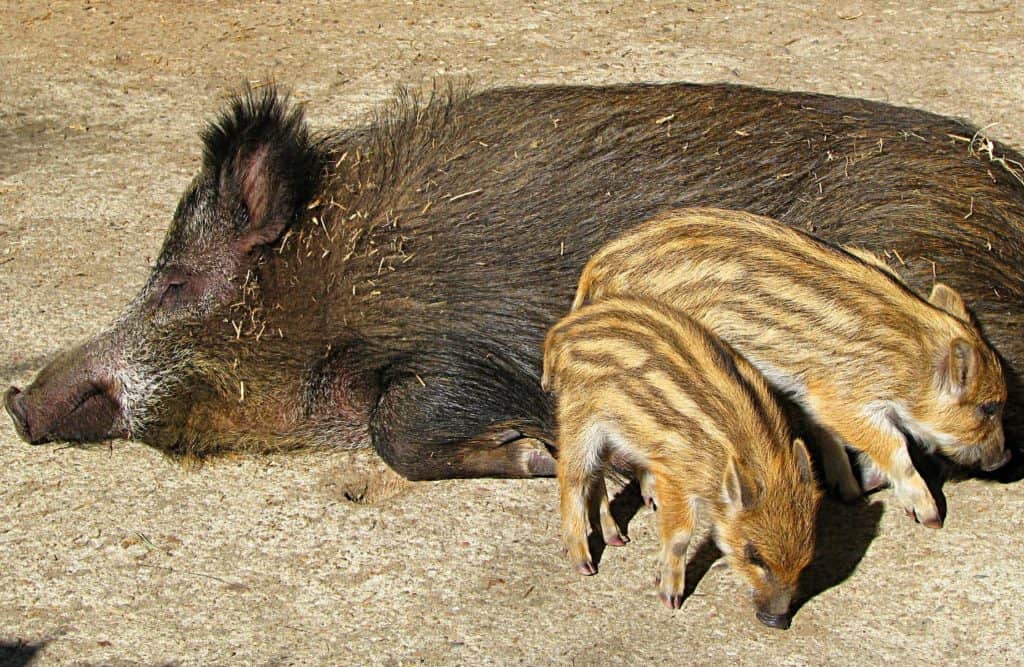
Contraceptive-laced pig feed can reduce feral hogs’ ability to reproduce.
©Jarosław Pocztarski / CC BY 2.0 – License
What’s the Solution?
Feral hogs in New York and around the country are a manmade problem that will ultimately require a manmade solution. This invasive species has demonstrated its ability to multiply explosively in all sorts of different ecosystems. In terms of natural selection, the only way to deal with such a species is to replace it with a stronger species that is better able to take its place in the environment. Unless we’re prepared to release large numbers of bears, wolves, and mountain lions into every part of the country, it is up to human beings to be the apex predator in this situation, reverse our mistake, and remove these creatures as humanely as possible from the environment.
The photo featured at the top of this post is © Mircea Costina/Shutterstock.com
Thank you for reading! Have some feedback for us? Contact the AZ Animals editorial team.




